|
Cantata BWV 104
Du Hirte Israel, höre
Examples from the Score |
|
Mvt. 1: Chorus | Mvt. 2: Recitative [Tenor] | Mvt. 3: Aria [Tenor] | Mvt. 4: Recitative [Bass] | Mvt. 5: Aria [Bass] | Mvt. 6: Chorale |
| |
|
Mvt. 1: Chorus |
|
In Example 1 |
|

|
|
you can see the anticipatory staccato notes in the oboes, and in part also, the strings. This prepares us for the words "höre" ("listen") and "erscheine" ("appear") when they occur in the voices. Notice also the 'drone' bass line, in imitation of the bagpipes, whereas the oboes imitate the schawms that would be present in a rural, pastoral, environment. The drone bass continues here for 7 measures. Later, when the chorus enters, it stays on the same note for 12 measures. Then later once more for 7, then for two shorter stretches of 5 measures each. Notice the phrasing marks in the violins! Ex. 2 |
|
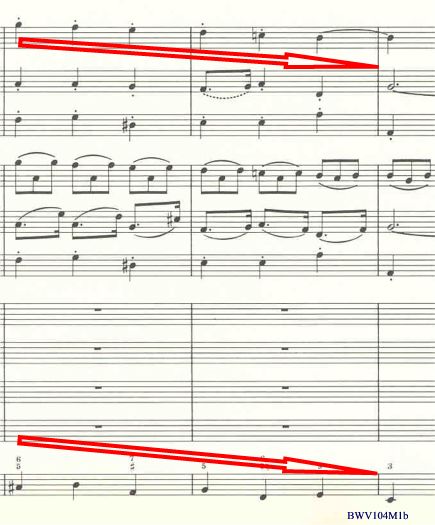
|
|
is excerpted from the introductory passage before the chorus enters. It, as well as another passage that follows a few measures later (ex. 3) |
|
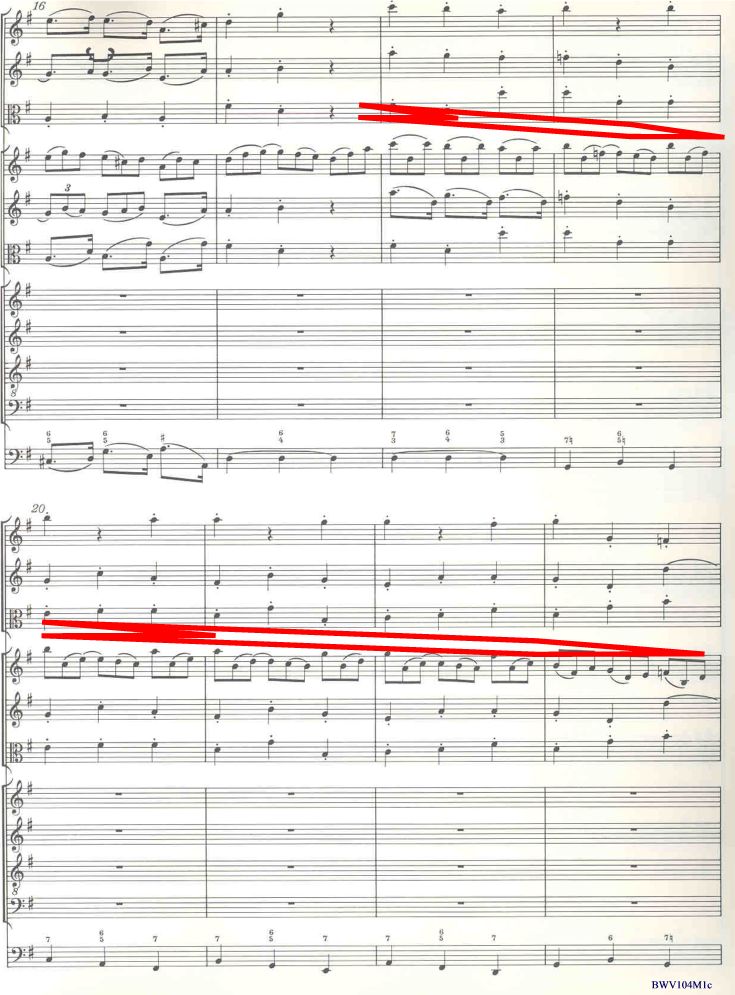
|
|
show a rather interesting downward movement. It is rather apparent that this is deliberate, particularly in ex. 3. Does this imply that Abba, Father, already anticipates our wish for him to appear and listen to what we have to say to him? The German word "neigen," which is not mentioned anywhere in the cantata, does come to mind, because it implies 'a bending down with kindness and affection to listen to, or to be inclined toward someone because of a special preference.' One caveat before jumping to conclusions here is that we really do not know the original thoughts and ideas expressed in this mvt. Perhaps this is a remnant of a notion expressed in the original, a cantata to celebrate the conferring of a new status at the university. Then the honor would come from above, as if a crown were being placed on the recipient's head. |
|
There is nothing here (ex. 4) |
|

|
|
to indicate that the last syllable of "höre" ("listen") should be so abruptly terminated the way Leusink's choir sings it. The beginning of the fugal entries in the tenor voice demonstrates the musical line which lacks a close connection with the words that are sung at the same time (ex. 5) |
|
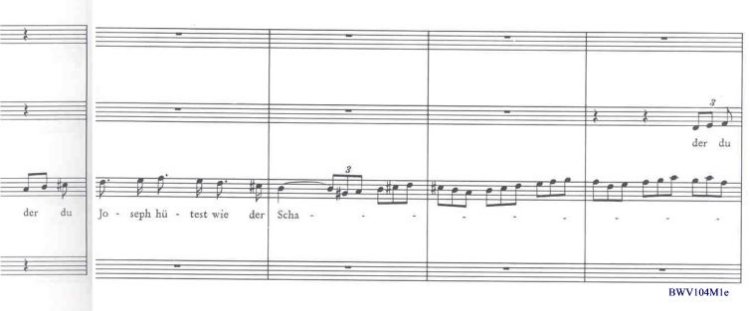
|
|
Here, again, the original conception of this fugal motif has been lost and probably illustrated more closely the words that were sung to it. The second time the fugal entries are presented (ex. 6), |
|
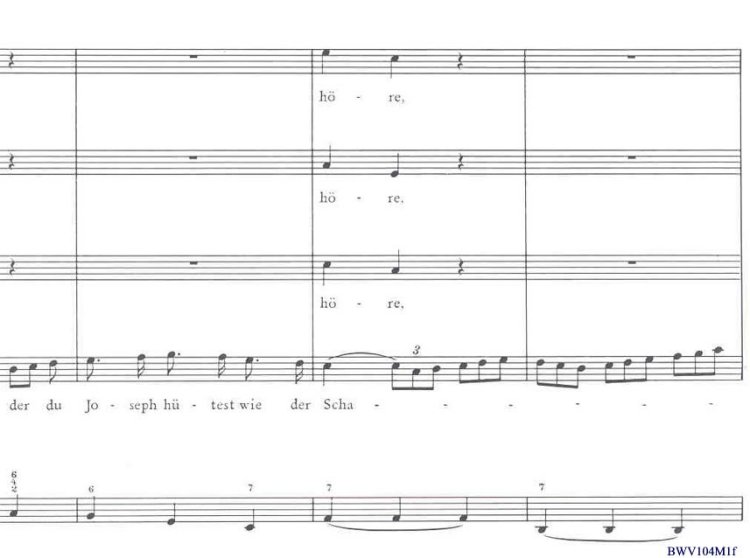
|
|
Bach combines the blocks of homophonic choral sounds created to illustrate the word, "höre" ("listen") with the fugue which now begins with the bass and not the tenor. |
| |
|
Mvt. 2: Recitative [Tenor] |
|
Typical word illustration occurs on the word "höchste" ("highest") as the tenor reaches for a high note (ex. 7). |
|

|
|
Frequently a recitative includes in the middle or toward the end of the recitative, an arioso section. Although this is simply marked by "Andante," it really is an arioso, where the voice becomes more lyrical. Note the unusual accent marks above the notes of the continuo. They seem to indicate a greater degree of firmness, an unusual incisiveness used to underline the belief that the tenor is singing about. |
| |
|
Mvt. 3: Aria [Tenor] |
|
This tenor aria illustrates clearly a profound connection between the words being sung and the music composed to illustrate them. It is very unlikely that this aria could have been part of the cantata that was being parodied. The first example (ex. 8) |
|
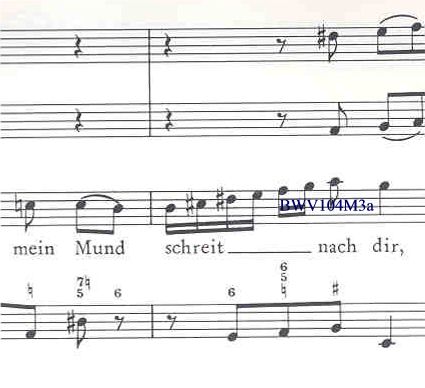
|
|
shows how Bach allows the tenor to really express the word "schreit" ("cry out") with a quick upward sweep of notes. The second example (ex. 9) |
|
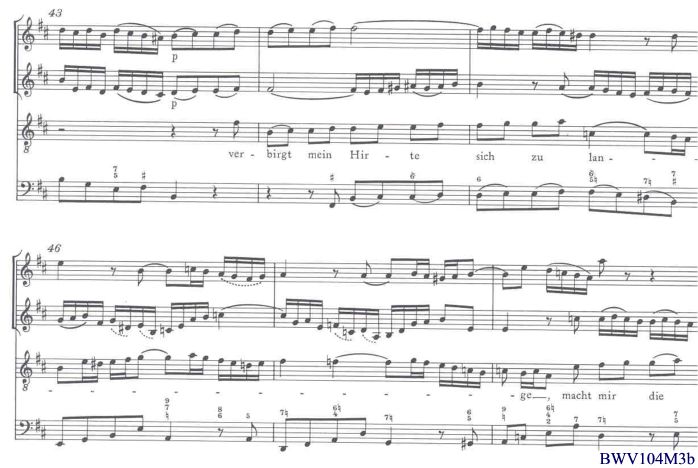
|
|
illustrates the word "lange" ("long in duration") with a long melisma. Another example of a direct connection is with the word, "eilt" ("hurry") as shorter note values prevail. Notice the divergence of bass line and the tenor line (ex. 10) |
|
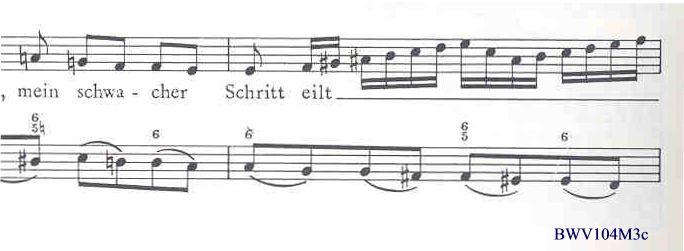
|
|
The most effective example in this movement is for the words "allzu bange" ("all too fearful"), where the oboi d'amore combine with the voice to move down chromatically in such a way that it causes a 'sinking feeling' in the listener (ex. 11). |
|

|
|
This is truly a masterpiece in affective musical composition. |
| |
|
Mvt. 4: Recitative [Bass] |
|
With the words, "und führe uns in dein Schafstall ein" ("and lead us to your sheep stall") (ex. 12) |
|

|
|
Bach moves the musical line upwards, because 'up there' in heaven the sheep will find a 'homey' resting place devoid of fear, a place prepared for them by Christ, the good shepherd. The anonymous poet and Bach, being able to consider established religious thought while, at the same time entertaining esoteric Christian ideas, that were not part of the mainstream, could invoke with a single word choice ("Schafstall") a double meaning: 1) the final resting place for deceased souls that follow the Shepherd, 2) or the expression of a negative goal, inactivity, caused by infantile impatience and a lack of contemplation on the part of an unthinking individual, whose primary goal is only quick, personal comfort and the avoidance of challenges here on earth. |
| |
|
Mvt. 5: Aria [Bass] |
|
This example taken from the end of the middle section where the bass sings "Todesschlafe" ("the sleep of death") (ex. 13) |
|
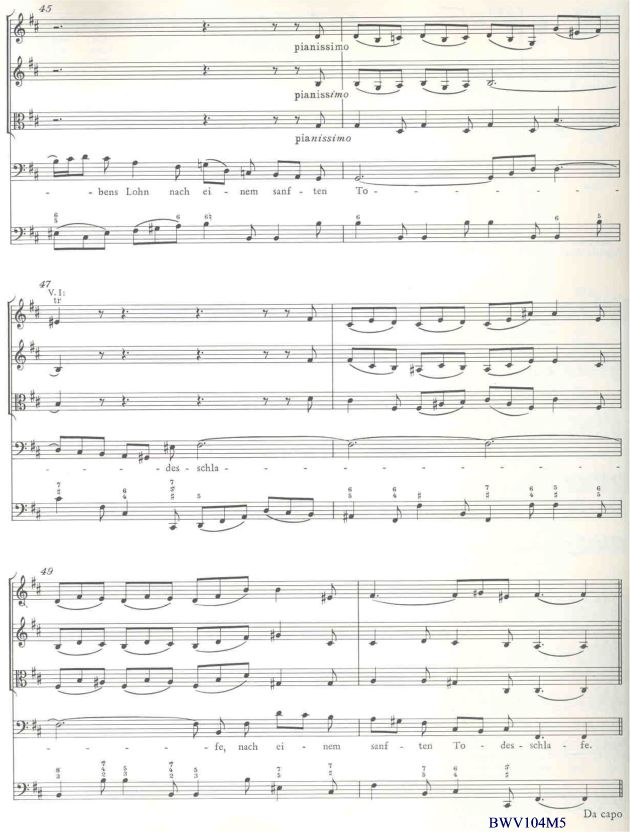
|
|
allows us to see the phrasing in the violins which is similar throughout the aria, as well as one of the most striking moments in the entire cantata. Depending upon the interpretation used, it can be treated in such a way as to exhibit horror in the face of death as an individual draws his last breaths, or it can be an inspiration as it gives hope to all believing Christians. Judging from the pastoral environment that permeates the entire mvt., it probably points to the latter interpretation. |
| |
|
Mvt. 6: Chorale |
|
The final example (ex.14) |
|

|
|
illustrates a downward motion in numerous places (reminiscent of the introduction to mvt. 1) but particularly strong on the words "{zur Weid er mich, sein Schäflein, führt} auf schöner, grünen Aue" ("{he leads me as his sheep} onto a beautiful, green, water meadow"). This, for me, is further proof that the poet/Bach is thinking of the earth as the place down to which Christ can lead us, and not up there 'on cloud nine' in that 'smelly sheep stall' which is not the primary goal of life, but rather a promise of guidance that awaits us, when we have expended all our efforts here on earth. |
| |
|
All snippets from NBA I/11.1
Contributed by Thomas Braatz (May 3, 2001) |